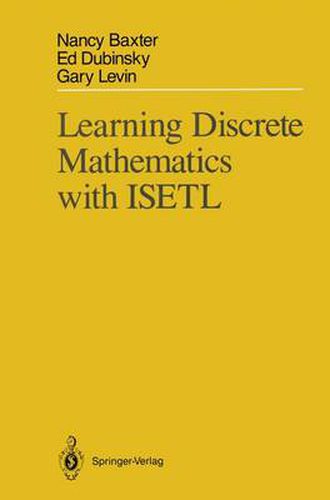Readings Newsletter
Become a Readings Member to make your shopping experience even easier.
Sign in or sign up for free!
You’re not far away from qualifying for FREE standard shipping within Australia
You’ve qualified for FREE standard shipping within Australia
The cart is loading…






This title is printed to order. This book may have been self-published. If so, we cannot guarantee the quality of the content. In the main most books will have gone through the editing process however some may not. We therefore suggest that you be aware of this before ordering this book. If in doubt check either the author or publisher’s details as we are unable to accept any returns unless they are faulty. Please contact us if you have any questions.
The title of this book, Learning Discrete Mathematics with ISETL raises two issues. We have chosen the word Learning rather than Teaching because we think that what the student does in order to learn is much more important than what the professor does in order to teach. Academia is filled with outstanding mathematics teachers: excellent expositors, good organizers, hard workers, men and women who have a deep understanding of Mathematics and its applications. Yet, when it comes to ideas in Mathe matics, our students do not seem to be learning. It may be that something more is needed and we have tried to construct a book that might provide a different kind of help to the student in acquiring some of the fundamental concepts of Mathematics. In a number of ways we have made choices that seem to us to be the best for learning, even if they don’t always completely agree with standard teaching practice. A second issue concerns students’ writing programs. ISETL is a pro gramming language and by the phrase with ISETL in the title, we mean that our intention is for students to write code, think about what they have written, predict its results, and run their programs to check their predic tions. There is a trade-off here. On the one hand, it can be argued that students’ active involvement with constructing Mathematics for themselves and solving problems is essential to understanding concepts.
$9.00 standard shipping within Australia
FREE standard shipping within Australia for orders over $100.00
Express & International shipping calculated at checkout
This title is printed to order. This book may have been self-published. If so, we cannot guarantee the quality of the content. In the main most books will have gone through the editing process however some may not. We therefore suggest that you be aware of this before ordering this book. If in doubt check either the author or publisher’s details as we are unable to accept any returns unless they are faulty. Please contact us if you have any questions.
The title of this book, Learning Discrete Mathematics with ISETL raises two issues. We have chosen the word Learning rather than Teaching because we think that what the student does in order to learn is much more important than what the professor does in order to teach. Academia is filled with outstanding mathematics teachers: excellent expositors, good organizers, hard workers, men and women who have a deep understanding of Mathematics and its applications. Yet, when it comes to ideas in Mathe matics, our students do not seem to be learning. It may be that something more is needed and we have tried to construct a book that might provide a different kind of help to the student in acquiring some of the fundamental concepts of Mathematics. In a number of ways we have made choices that seem to us to be the best for learning, even if they don’t always completely agree with standard teaching practice. A second issue concerns students’ writing programs. ISETL is a pro gramming language and by the phrase with ISETL in the title, we mean that our intention is for students to write code, think about what they have written, predict its results, and run their programs to check their predic tions. There is a trade-off here. On the one hand, it can be argued that students’ active involvement with constructing Mathematics for themselves and solving problems is essential to understanding concepts.